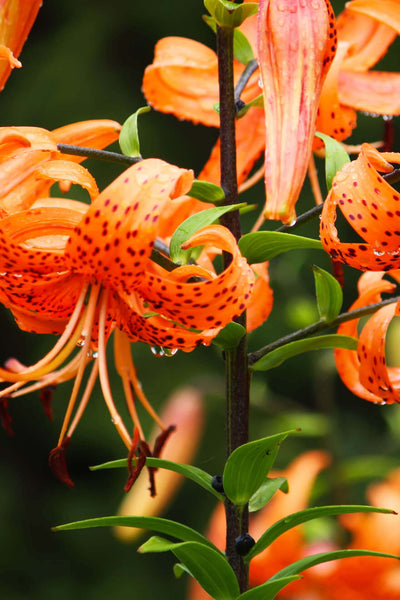The tiger lily is a popular flower amongst gardeners and the non-botanical crowd. The tiger lily is an exotic, tropical-looking flower with a thick, tubular shape. Wild tiger lilies are not hard to come by, and you can see them growing throughout North America. Tiger lilies will often bloom through the warm summer months and have blossoms reminiscent of fire and lightning with their bold shapes and intense colors. it is a stunning deer restaurant perennial.
Description
The tiger lily grows from bulbs, usually around 15 centimeters (6 inches) in diameter. Each bulb produces up to six leaves during its growth cycle. The leaves are long and strap-like, growing up to 60 centimeters (2 feet) long and 5 centimeters (2 inches) wide. These leaves have parallel veins running down them, giving them their striped appearance.
The flowers on the Tiger Lily come in two different forms: those with curled petals and those with straight petals. Both types of the flower have orange-yellow centers with red stripes running vertically down them; however, some flowers have no stripes at all while others may be solid orange or yellow instead of having any red markings at all.
Growing From Seed
Tiger lilies are among the easiest bulbs to grow from seed but take a while to produce blooms. To get the most out of your tiger lily seeds, plant them in pots or flats and grow them indoors. When transplanting them into their permanent location outside, harden off the plants before setting them in the ground.
Plant the seeds 1/2 inch deep in early spring or fall. Germination should occur within two weeks at 65 degrees F (18 C). Once they've germinated and begun growing, keep the soil moist but not soggy until they've reached 3 inches tall and developed their first true leaves. The seedlings should be ready for transplant by midsummer if you start them indoors in early spring.
Hardiness Zones
The tiger lily is a species of lily in the genus Lilium. It is native to North America. It grows best in USDA Hardiness Zones 6, 7 and 8 and can be grown annually in other parts of the country. It is also native to Mexico, Guatemala and Honduras.
Potting
Tiger lilies can be grown indoors or outdoors but need full sunlight to thrive. The plants grow from bulbs, which can be planted directly into the ground or potted for indoor use.
- Step 1
- To improve drainage, prepare your potting soil by adding compost, peat moss, and perlite.
- Step 2
- Plant the bulb upside down with just the tip showing above ground level. This will prevent it from rotting due to too much water.
- Step 3
- Water regularly until the flower blooms, then reduce watering once the plant dies back in the fall.
Light Requirements
Tiger lilies need at least six hours of direct sunlight every day. The more sunlight they receive, the more flowers they will produce. If you live in an area with only four hours of direct sunlight each day, plant them in partial shade so they get enough light without overheating during the hottest part of the summer months (July through September).
Water Requirements
Tiger lilies require frequent watering during their growing season and should never be allowed to dry out completely. If you notice the leaves yellowing, then it is likely that your plant needs more water than it is receiving.
The best time for watering is early morning or evening so that the plants do not get too hot from direct sunlight while they are still wet from watering. You should also avoid watering your plants if it is windy outside, as this may cause excess moisture loss from the plant leaves.
During hot periods, especially in an area with high temperatures, try to water your plants less often so they do not become overly stressed by the heat and dry conditions. If your area has a lot of rain throughout the year, you will only need to water every two weeks or so during the growing season when it becomes warmer outside and your plant begins putting on new growths of leaves.
Soil Requirements
Tiger lilies prefer moist soil that drains well but doesn't have standing water in the planting area for long periods. Avoid soggy conditions at all costs because they will lead to root rot problems for your plant. If your area is humid or near a body of water, ensure you give your plants plenty of drainage space so they don't sit in water during heavy rains or after watering them. Tiger lily bulbs prefer slightly acidic soils with a pH between 5 and 7 (slightly acidic) or neutral (pH 7). A pH below 5 indicates acidic soil, while a pH above 7 indicates basic soil (alkaline).
Fertilizing
Tiger lilies do not require much fertilizer, but they will benefit from applying compost before planting and once a year after blooming. If you grow your tiger lilies in containers, use a fertilizer with equal amounts of, phosphorous (P), nitrogen (N) and potassium (K). Use one tablespoon per gallon of water when watering your lilies.
Pests and Disease Problems
Tiger lilies are susceptible to aphids, slugs and snails. Aphids feed on the sap of plants by inserting their mouthparts into them. They can also spread viral diseases that affect the plant's foliage. Snails and slugs eat holes in your tiger lily leaves, which can cause them to wilt or die.
The most common diseases occur on the roots, leaves and stems. It causes spots on the leaves and yellows them. The fungus can also cause brown spots on the petals of some varieties of a tiger lilies. The most common disease is leaf scorch, which causes brown areas on the leaves. This condition occurs when the plant is not watered enough and has too much sun exposure. It can also be caused by over-fertilizing or under-watering. Leaf scorch will cause yellowing or browning of some areas of the leaf, but it will not kill off your plant completely if you correct these conditions quickly enough.
When To Plant It
Tiger lily bulbs should be planted anytime between fall and spring, as long as the ground isn't frozen or waterlogged. The best time to plant your bulbs is early spring before the last frost date, usually about mid-April in most regions. However, if you want to start growing your plants indoors for spring planting on your patio, it's best to start them around May 1st or sooner.
How To Plant Tiger Lily in Your Garden
Dig a hole two times as wide and deep as the root ball of your plant. Fill the hole with an amended soil mix, including compost, peat moss, and sand or perlite. Add water to this mix before filling the hole to avoid compacting it. Place your plant in this hole and fill it with soil. Gently firm the soil down around the roots and water it well.
Water your new tiger lily at least once a week until it is established in its new location. Make sure to allow at least one foot between each plant, so they have plenty of room for their large leaves and flowers.
Companion Plants
Tiger lilies are a great garden plant but can be a bit finicky. If you're looking for companion plants for your tiger lily, consider these suggestions:
Alyssum: This plant grows well with tiger lilies because it needs similar conditions and doesn't compete for nutrients. It's also resistant to pests like aphids and thrips, which helps keep your tiger lilies healthy.
English ivy: This ground cover protects your tiger lilies from cold winter temperatures by acting as an insulator around their roots. However, it won't take over your garden because it doesn't grow as tall as other ground covers.
Evening primrose: This herb attracts pollinators to your garden by producing nectar that helps them survive through winter months when most other plants aren't blooming anymore (it also produces seeds that birds like to eat).

